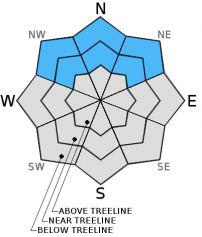| Friday | Friday Night | Saturday | |
|---|---|---|---|
| Weather: | Sunny with some cloud cover moving in this afternoon | Mostly cloudy becoming partly cloudy | Partly cloudy in the morning becoming sunny |
| Temperatures: | 31-37 deg. F. | 22-30 deg. F. | 34-40 deg. F. |
| Mid Slope Winds: | NE | N | N shifting to the NE |
| Wind Speed: | 20-35 mph with gusts to 50 mph | 25-35 mph with gusts to 50 mph | 35-40 mph with gusts to 60 mph decreasing to 25-35 mph with gusts to 50 mph in the afternoon |
| Expected snowfall: | 0 | 0 | 0 |
| Friday | Friday Night | Saturday | |
|---|---|---|---|
| Weather: | Sunny with some cloud cover moving in this afternoon | Mostly cloudy becoming partly cloudy | Partly cloudy in the morning becoming sunny |
| Temperatures: | 28-35 deg. F. | 21-26 deg. F. | 32-38 deg. F. |
| Ridge Top Winds: | NE | N | N |
| Wind Speed: | 40-50 mph with gusts to 65 mph | 45-55 mph with gusts to 70 mph | 45-55 mph with gusts to 75 mph decreasing to 35-45 mph with gusts to 60 mph in the afternoon |
| Expected snowfall: | 0 | 0 | 0 |

























